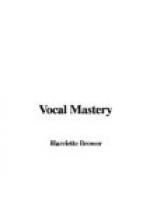Frieda Hempel says: “I do about two hours or more, though not all of this for technic. I approve of a good deal of technical study, taken in small doses of ten to fifteen minutes at a time. Technic is a means to an end, more in the art of song than in almost any other form of art. Technic is the background of expressive singing.”
Sophie Braslau is an incessant worker,—“at least six hours a day. Of these I actually sing three hours. The first hour to memory work on repertoire. The second hour to vocalizes. The rest of the time is given to repertoire and the things that belong to it.” Barrientos states she gives about three-quarters of an hour to vocal technic—scales and exercises—each day. Duval advises the young student to practice two half hours daily, two hours after eating, and rest the voice one day each week, during which she studies other subjects connected with her art. Oscar Saenger says: “One should practice in fifteen-minute periods, and rest at least ten minutes between. Sing only two hours a day, one in the morning and one in afternoon.”
WHAT VOWELS TO USE
There seems a divergence of opinion as to what vowels are most beneficial in technical practice and study. Galli-Curci says: “In my own study I use them all, though some are more valuable than others. The Ah is the most difficult of all. The O is good; E needs great care. I have found the best way is to use mixed vowels, one melting into the other. The tone can be started with each vowel in turn, then mingled with the rest of the vowels.” Mme. d’Alvarez often starts the tone with Ah, which melts into O and later changes to U, as the tone dies away. Bispham has the student use various vowel syllables, as: Lah, Mah, May, and Mi. With Oscar Saenger the pupil in early stages at least, uses Ah for vocalizes. Duval requires students to use the vowel Ah, for exercises and scales, finding the others are not needed, especially excluding E and U as injurious. Griffith uses each vowel in turn, preceded by all the consonants of the alphabet, one after another.




